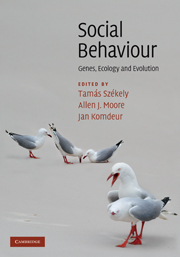Book contents
- Frontmatter
- Contents
- List of contributors
- Introduction: The uphill climb of sociobiology: towards a new synthesis
- Profile: Undiminished passion
- Part I Foundations
- Part II Themes
- 7 Aggression: towards an integration of gene, brain and behaviour
- Profile: From behavioural observations, to genes, to evolution
- 8 Social influences on communication signals: from honesty to exploitation
- Profile: Reputation can make the world go round – or why we are sometimes social
- 9 Important topics in group living
- Profile: A haphazard career
- 10 Sexual behaviour: conflict, cooperation and coevolution
- Profile: In celebration of questions, past, present and future
- 11 Pair bonds and parental behaviour
- Profile: Mating systems and genetic variation
- 12 Adaptations and constraints in the evolution of delayed dispersal: implications for cooperation
- Profile: Selections from a life in social selection
- 13 Social behaviour in microorganisms
- Profile: The de novo evolution of cooperation: an unlikely event
- 14 Social environments, social tactics and their fitness consequences in complex mammalian societies
- Profile: Evolutionary genetics and social behaviour: changed perspectives on sexual coevolution
- 15 Social behaviour in humans
- Profile: Genes and social behaviour: from gene to genome to 1000 genomes
- Part III Implications
- Species index
- Subject index
- References
9 - Important topics in group living
Published online by Cambridge University Press: 05 June 2012
- Frontmatter
- Contents
- List of contributors
- Introduction: The uphill climb of sociobiology: towards a new synthesis
- Profile: Undiminished passion
- Part I Foundations
- Part II Themes
- 7 Aggression: towards an integration of gene, brain and behaviour
- Profile: From behavioural observations, to genes, to evolution
- 8 Social influences on communication signals: from honesty to exploitation
- Profile: Reputation can make the world go round – or why we are sometimes social
- 9 Important topics in group living
- Profile: A haphazard career
- 10 Sexual behaviour: conflict, cooperation and coevolution
- Profile: In celebration of questions, past, present and future
- 11 Pair bonds and parental behaviour
- Profile: Mating systems and genetic variation
- 12 Adaptations and constraints in the evolution of delayed dispersal: implications for cooperation
- Profile: Selections from a life in social selection
- 13 Social behaviour in microorganisms
- Profile: The de novo evolution of cooperation: an unlikely event
- 14 Social environments, social tactics and their fitness consequences in complex mammalian societies
- Profile: Evolutionary genetics and social behaviour: changed perspectives on sexual coevolution
- 15 Social behaviour in humans
- Profile: Genes and social behaviour: from gene to genome to 1000 genomes
- Part III Implications
- Species index
- Subject index
- References
Summary
Overview
Given the vast topic of group living, this chapter highlights research areas into group living that continue to attract considerable attention or represent new developments. By these criteria, three topics stood out to us: the selfish herd, social networks and collective behaviour. The selfish herd is the idea that aggregation of prey animals can occur simply through the selfish actions of individuals positioning themselves so as to reduce their risk of attack. This idea is very much at the core of why animals live in groups, and the theory has been influential for a considerable period. The idea of the selfish herd is simple but subtle, and we decided to discuss it carefully, since textbook discussions on this concept often ignore four aspects of complexity: more complex and realistic geometries than are normally considered; the underlying behavioural rules that might lead to selfish herd effects; the predicted outcome of such rules in terms of properties of the group; and the interaction of selfish herd effects with other selective pressures on group size, shape and composition.
The second emerging field we choose is the application of social network analysis (a conceptual and statistical tool from the social sciences) to animal groups and populations. Although this topic is not completely new, recent developments represent an exponential increase in new tools for studying social networks that makes network analysis a powerful method to understand social organisation.
- Type
- Chapter
- Information
- Social BehaviourGenes, Ecology and Evolution, pp. 203 - 225Publisher: Cambridge University PressPrint publication year: 2010
References
- 7
- Cited by



